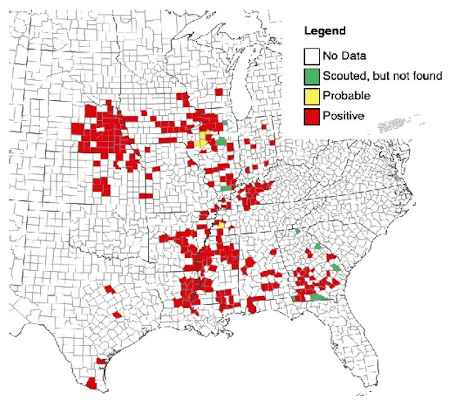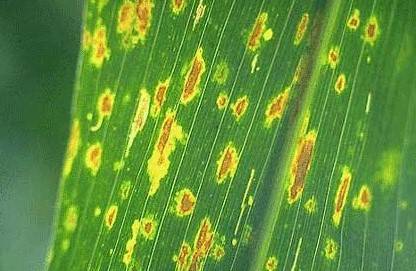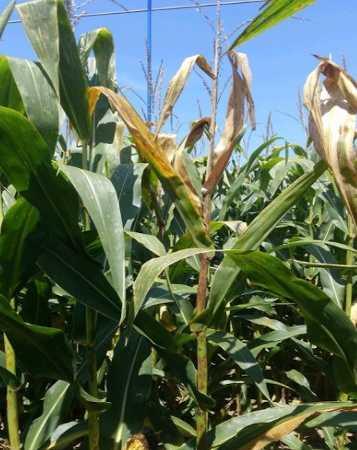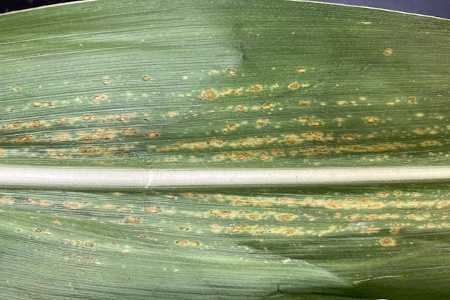By Kelsey Andersen and Eric Adee et.al
Corn in Kansas is rapidly progressing toward maturity with many fields having reached the hard dough to early dent stage of development. Most necessary fungicide applications have already been made, and there will be minimal returns to fungicide application made after dent. Later planted fields have or are just reaching the critical blister stage of development and should certainly be scouted for fungal disease development, severity, and progress.
Southern rust
Southern rust has been showing up in counties across eastern and central Kansas for the past few weeks (Figure 1). In northeast, north central, and east central Kansas, symptoms can be found in many fields, although most at very low levels. Fungicides will only be profitable prior to R4, if southern rust is moving into the upper canopy on > 30% of plants. Later planted fields that have just pollenated should be carefully scouted until the late soft dough stage of development. Cooler weather this past week may have slowed southern rust development, but scouting efforts should continue.

Figure 1. Map of reported southern rust distribution as of August 7, 2020.
Gray leaf spot
Late fields that are not past R2 should be evaluated for gray leaf spot (Figure 1), as there have been reports of the disease moving into the upper canopy in eastern Kansas. Fields that are in or past the hard dough stage should not be sprayed with fungicides, even if gray leaf spot incidence in high, as this application would not be profitable. The K-State Hybrid Performance Tests and fungicide test plots at the Kansas River Valley Experiment Fields (KRV) at Silver Lake and Rossville have high levels of gray leaf spot, but the crop has already reached dent stage. Gray leaf spot severity is variable between commercial fields. This could be due to fungicide applications, hybrid resistance, or because weather conditions in the field were not conducive for disease development. More information about gray leaf spot can be found here: https://bookstore.ksre.ksu.edu/pubs/mf2341.pdf

Figure 2. Early development of gray leaf spot lesions showing a distinct yellow halo.
Stalk rots and top dieback
As corn moves to maturity, stalk rots are starting to be reported. In the K-State irrigated hybrid performance trial in Shawnee County, most hybrids have symptoms of Anthracnose stalk rot. Now would be the time be on the lookout for other stalk rots, such as charcoal rot and Fusarium stalk rot. Wet weather over the last two weeks has been favorable for stalk rot development. Fields with stalk rot should be targeted for early harvest to prevent lodging.
A different symptom of the same disease that causes Anthracnose stalk rot is Anthracnose top dieback (Figure 3). This week, the beginnings of Anthracnose top dieback have begun to show up at KRV. In 2016, top dieback infections resulted in significant yield losses (13+ bu/a) compared to plots treated with fungicides at tasseling and later.

Figure 3. Anthracnose top dieback in irrigated Hybrid Performance trials at the Kansas River Valley Experiment station.
Lesion mimic
An unusual symptom has been found in a small number of fields in northeast Kansas, known as corn lesion mimic (Figure 4). This symptom can be confused with disease, but no pathogen has been recovered from the lesions. It is believed that this disorder is genetic. Fungicides will not have any effect on this disorder.

Figure 4. Symptoms of corn lesion mimic, a disorder not known to be caused by a pathogen.
Soybean disease update
The soybean crop is amazingly healthy at this point and fields are in the R3 to R5 growth stages.
Frogeye leaf spot is just showing up at very low levels in northeast Kansas, with no fields observed with levels of the disease that would warrant a fungicide application. In addition to frogeye leaf spot, there have been a few reports of sudden death syndrome symptoms. Sudden death syndrome is typically most apparent around R3. Symptoms (Figure 5) are the result of infection of the roots by a fungal pathogen. There are seed treatment options for the control of sudden death syndrome at planting, and foliar fungicides should not be used to control this disease.
The predominant diseases spotted in soybeans have been Septoria brown spot and bacterial blight. Bacterial blight is associated with big, blowing thunderstorms that spread bacteria around the field. Fungicides will not be effective on bacterial diseases; however, this disease is not known to be yield limiting.
Septoria brown spot, also known as brown spot, has developed in the lower canopies across the soybean growing region and is often confused with frogeye leaf spot. Brown spot development was favored in dense canopies by warm/hot, moist weather, which promoted sporulation of the pathogen in the primary lesions. Severity increases due to increasing leaf wetness periods of 6 to 36 hours. Conidia are dispersed by wind or splashing rain. The optimum temperature for brown spot development is 77°F, but disease symptoms develop at 60-85°F. Fungicide treatment is effective in controlling brown spot, but rarely, if ever, warranted.
Fungicides for foliar disease problems are rarely warranted at this point of the season. Results from 27 replicated studies conducted from 2007-2019 across northeast and east central Kansas have indicated a positive return on investment by properly applying fungicides to soybeans only 35-40% of the time. Fungicide efficacy ratings for various soybean diseases can be found at: https://cropprotectionnetwork.org/resources/publications/fungicide-efficacy-for-control-of-soybean-foliar-diseases.
Source : ksu.edu